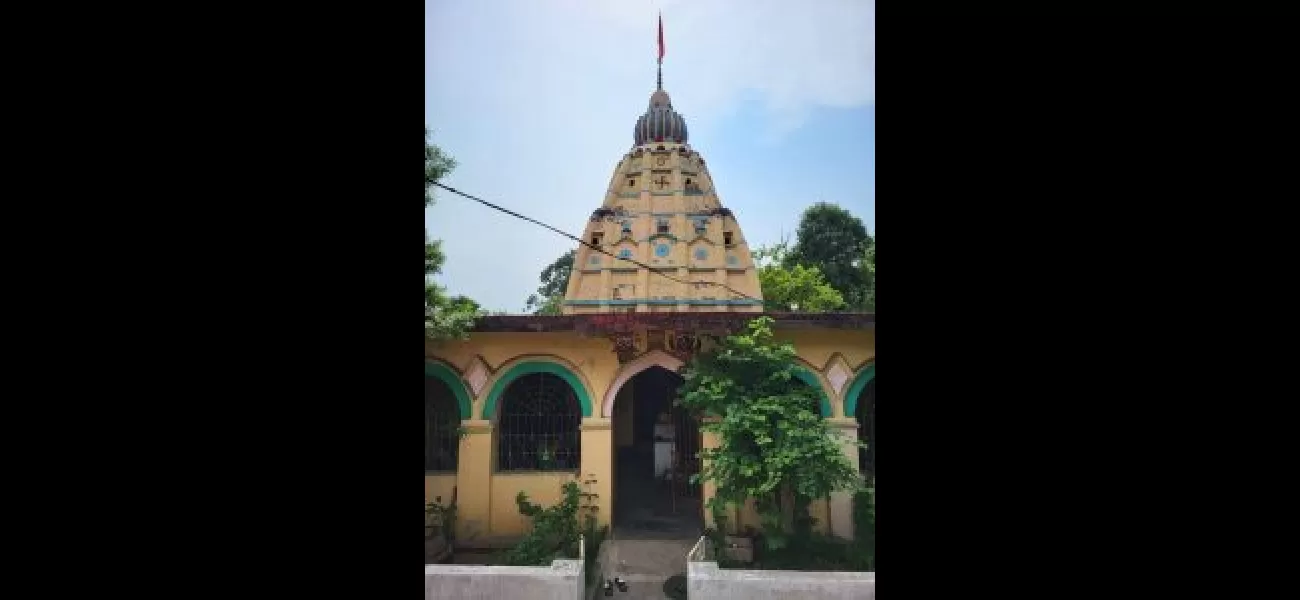A special and culturally significant tradition, the Balanda Rath Yatra has been celebrated for 114 years.
Rourkela: Balanda village in Sundargarh district has a special Rath Yatra tradition, with locals pulling the chariot a day after Puri's celebration. The village has a rich Jagannath culture.
July 15th 2024.

The village of Balanda, nestled in the Sundargarh district, is a peaceful and quaint place that holds a special place in the hearts of its residents. Its unique Rath Yatra, a holy festival celebrating the sibling deities Jagannath, Balabhadra, and Subhadra, is a tradition that has been passed down for generations.
Located about 1.5km away from the Kalunga railway station, Balanda may seem like a remote and isolated village, but it boasts of a rich and ancient Jagannath culture. In fact, it is one of the few places in the state that has been celebrating Rath Yatra for over 114 years. The villagers take great pride in their unique festival and its interesting history, which has a royal connection.
According to Pradeep Parida, a Rath Yatra organizer from Balanda, there are many places in the state that have a history of Rath Yatra celebrations, but what sets theirs apart is the remote location and the fascinating legacy behind it. In the past, Balanda was under the rule of the Nagra Estate, as part of the Kuanrmunda zamindar. Dr. Prabhat Mallick, a renowned historian who has studied the royal families of the district, explains that during the Raj, the zamindars used to appoint 'gountias' or 'ganjus' to collect taxes and settle minor legal and social disputes.
One such 'gountia' was Arjun Raj, who was known for his arrogance and often had disagreements with the zamindars. Eventually, he was removed from his position and Balanda, along with two other villages, was put up for auction. Jagatram, a wealthy resident of Jharsuguda, bought the villages and became the new chief. His youngest son, Dayanidhi Nayak, was given the responsibility of Balanda.
As the story goes, Dayanidhi had a dream where he saw the idols of the sibling deities floating on water, and a divine voice told him to retrieve them. The news spread quickly, and even reached the Kuanrmunda zamindar. To everyone's surprise, the idols were found floating near the sacred confluence of Vedvyas, and were brought to the banks by fishermen. The zamindar then appointed Jagannath Das as the servitor and priest, and the deities were installed with all due rituals.
However, a few months later, the zamindar instructed Dayanidhi to shift the deities to Balanda. The reason being, Dayanidhi had seen the idols in his dream, and it was only fitting that he install them in his village. Makhlu Oram, a villager, explains that the zamindar's instructions also came with a condition - the Rath Yatra at Balanda should be observed a day after the Kuanrmunda celebrations. Since then, the villagers have followed this tradition strictly.
For over a century, the deities were kept in a small room with a tiled roof. It was only in 1997-98, with financial assistance from the villagers and other donors, that the present temple in Balanda was constructed by the then 'gountia', Narendra Patel. However, some locals have a different version of the story. They believe that the deities were originally worshipped in a Brahmin village in Jharkhand, and for some reason, they were released into the River Koel, where Dayanidhi's dream coincided with their arrival.
Interestingly, the position of the priest has been passed down from generation to generation. Sukadev Dash was appointed as the priest in 1926, and later his son, Bhagirathi, took over. Today, Bhagirathi's son, Lingaraj, who lives in Junen village and works as a priest there, continues to carry on the legacy. After the passing of Narendra Patel, his daughter Dr. Minu Patel and son-in-law Dr. Nimain Patel have taken charge of the Rath Yatra celebrations and bear all the expenses.
During the 10-day festival, the villagers participate in the chhera pahanra ritual, where newborns are brought to touch the chariot for good luck and blessings from the deities. This tradition has been followed for years, and the villagers believe that it brings good fortune and prosperity to the newborns. The Rath Yatra of Balanda may be a small and remote celebration, but it holds a special place in the hearts of its residents and continues to be an important part of their culture and heritage.
Located about 1.5km away from the Kalunga railway station, Balanda may seem like a remote and isolated village, but it boasts of a rich and ancient Jagannath culture. In fact, it is one of the few places in the state that has been celebrating Rath Yatra for over 114 years. The villagers take great pride in their unique festival and its interesting history, which has a royal connection.
According to Pradeep Parida, a Rath Yatra organizer from Balanda, there are many places in the state that have a history of Rath Yatra celebrations, but what sets theirs apart is the remote location and the fascinating legacy behind it. In the past, Balanda was under the rule of the Nagra Estate, as part of the Kuanrmunda zamindar. Dr. Prabhat Mallick, a renowned historian who has studied the royal families of the district, explains that during the Raj, the zamindars used to appoint 'gountias' or 'ganjus' to collect taxes and settle minor legal and social disputes.
One such 'gountia' was Arjun Raj, who was known for his arrogance and often had disagreements with the zamindars. Eventually, he was removed from his position and Balanda, along with two other villages, was put up for auction. Jagatram, a wealthy resident of Jharsuguda, bought the villages and became the new chief. His youngest son, Dayanidhi Nayak, was given the responsibility of Balanda.
As the story goes, Dayanidhi had a dream where he saw the idols of the sibling deities floating on water, and a divine voice told him to retrieve them. The news spread quickly, and even reached the Kuanrmunda zamindar. To everyone's surprise, the idols were found floating near the sacred confluence of Vedvyas, and were brought to the banks by fishermen. The zamindar then appointed Jagannath Das as the servitor and priest, and the deities were installed with all due rituals.
However, a few months later, the zamindar instructed Dayanidhi to shift the deities to Balanda. The reason being, Dayanidhi had seen the idols in his dream, and it was only fitting that he install them in his village. Makhlu Oram, a villager, explains that the zamindar's instructions also came with a condition - the Rath Yatra at Balanda should be observed a day after the Kuanrmunda celebrations. Since then, the villagers have followed this tradition strictly.
For over a century, the deities were kept in a small room with a tiled roof. It was only in 1997-98, with financial assistance from the villagers and other donors, that the present temple in Balanda was constructed by the then 'gountia', Narendra Patel. However, some locals have a different version of the story. They believe that the deities were originally worshipped in a Brahmin village in Jharkhand, and for some reason, they were released into the River Koel, where Dayanidhi's dream coincided with their arrival.
Interestingly, the position of the priest has been passed down from generation to generation. Sukadev Dash was appointed as the priest in 1926, and later his son, Bhagirathi, took over. Today, Bhagirathi's son, Lingaraj, who lives in Junen village and works as a priest there, continues to carry on the legacy. After the passing of Narendra Patel, his daughter Dr. Minu Patel and son-in-law Dr. Nimain Patel have taken charge of the Rath Yatra celebrations and bear all the expenses.
During the 10-day festival, the villagers participate in the chhera pahanra ritual, where newborns are brought to touch the chariot for good luck and blessings from the deities. This tradition has been followed for years, and the villagers believe that it brings good fortune and prosperity to the newborns. The Rath Yatra of Balanda may be a small and remote celebration, but it holds a special place in the hearts of its residents and continues to be an important part of their culture and heritage.
[This article has been trending online recently and has been generated with AI. Your feed is customized.]
[Generative AI is experimental.]
0
0
Submit Comment





